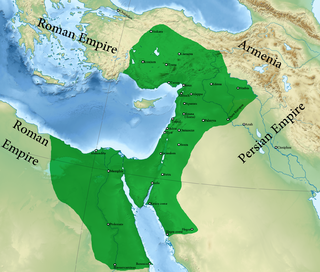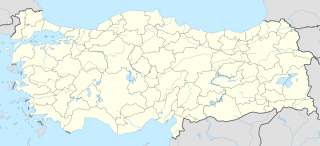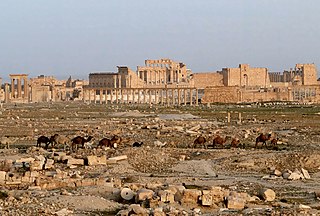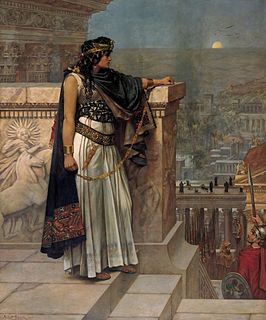Related Research Articles

The 3rd century AD was the period from 201 (CCI) to 300 (CCC).

Septimia Zenobia was a third-century queen of the Palmyrene Empire in Syria. Many legends surround her ancestry; she was probably not a commoner and she married the ruler of the city, Odaenathus. Her husband became king in 260, elevating Palmyra to supreme power in the Near East by defeating the Sassanians and stabilizing the Roman East. After Odaenathus' assassination, Zenobia became the regent of her son Vaballathus and held de facto power throughout his reign.

Septimius Odaenathus was the founder king (Mlk) of the Palmyrene Kingdom who ruled from Palmyra, Syria. He elevated the status of his kingdom from a regional center subordinate to Rome into a formidable state in the Near East. Odaenathus was born into an aristocratic Palmyrene family that had received Roman citizenship in the 190s under the Severan dynasty. He was the son of Hairan, the descendant of Nasor. The circumstances surrounding his rise are ambiguous; he became the lord (ras) of the city, a position created for him, as early as the 240s and by 258, he was styled a consularis, indicating a high status in the Roman Empire.
Orodes is the Latinized form of a male given name of Iranian origin popular among Parthians. People bearing the name include:

Lucius Julius Aurelius Septimius Vaballathus Athenodorus was emperor of the Palmyrene Empire centred at Palmyra in the region of Syria. He came to power as a child under his regent mother Zenobia, who led a revolt against the Roman Empire and formed the independent Palmyrene Empire.

The Battle of Emesa was fought in 272 between the Roman armies led by their emperor Aurelian and the Palmyrene forces led by their queen, Zenobia and general Zabdas.

The Battle of Immae was fought in 272 between the Roman army of Emperor Aurelian, and the armies of the Palmyrene Empire, whose leader, Queen Zenobia, had usurped Roman control over the eastern provinces.

The Palmyrene Empire was a short-lived splinter state of the Roman Empire resulting from the Crisis of the Third Century. Named after its capital city, Palmyra, it encompassed the Roman provinces of Syria Palaestina, Arabia Petraea, and Egypt, as well as large parts of Asia Minor.
Zabdas was a 3rd century Syrian general who led the forces of Queen Zenobia of Palmyra during her rule as regent of her son Vaballathus and her subsequent rebellion against the Roman Emperor under the short-lived independent Palmyrene Empire. He led Palmyra's expeditions in the middle east which included annexing territory spanning from Roman Egypt to Asia Minor.
Septimius Antiochus was a Roman usurper in Syria during the 3rd century.
Aurelius/Iulius Marcellinus was a Roman soldier and Imperial functionary who had a brilliant equestrian career and was elevated to the Senate when he was chosen by the Emperor Aurelian as his consular colleague. His appointment as Consul is thought to have been a reward for his loyalty and steadfastness in 273 when, as Aurelian's deputy in charge of the eastern provinces of the Empire where the authority of the Imperial Government had only recently been restored, he resisted attempts to suborn him by a rebellious faction in the city of Palmyra.
The Battle of Ctesiphon took place in 263 between the Sassanid Empire and Palmyrene army under the Palmyrene king Odaenathus. Following the Sasanians' defeat and loss of Syria and Cappadocia to the Roman Empire at the hands of Odaenathus and Balista; The Palmyrene monarch invaded Mesopotamia and stood at the walls of Ctesiphon and devastated the region around it, however he could not conquer it. The logistical problems of fighting in enemy territory forced the Palmyrenes to leave the siege carrying with them numerous prisoners and booty. The prisoners were sent to Rome, enabling the Roman emperor Gallienus to hold a triumph.

The Siege of Tyana occurred in 272 CE. The forces of the Roman Emperor Aurelian were seeking to conquer the Palmyrene Empire.

Palmyra is an ancient Semitic city in present-day Homs Governorate, Syria. Archaeological finds date back to the Neolithic period, and documents first mention the city in the early second millennium BC. Palmyra changed hands on a number of occasions between different empires before becoming a subject of the Roman Empire in the first century AD.

Septimius Herodianus or Hairan was the son and co-king of Odaenathus of Palmyra. Through his father's marriage to Zenobia, Hairan had two half brothers, one with the same name, Hairan II, and Vaballathus.
Hairan II was a Palmyrene prince, the son of king Odaenathus and, possibly, his second wife Zenobia.
Septimius Haddudan was a 3rd-century Palmyrene official, the only known Palmyrene senator other than Odaenathus, and a priest and symposiarch of the god Bel, who is known to have opposed the rule of Queen Zenobia of Palmyra and aided the Roman Empire during their wars against the queen.

Odaenathus, the king of Palmyra from 260 to 267 CE, has been identified by modern scholars as the subject of sculptures, seal impressions, and mosaic pieces. His city was part of the Roman Empire, and he came to dominate the Roman East when in 260 he defeated Shapur I, the Sasanian emperor of Persia, who had invaded the Roman Empire. Odaenathus besieged the Sasanian capital Ctesiphon in 263, and although the city did not fall, the campaign led to a full restoration of Roman provinces taken by Shapur I. In the aftermath of his Persian war, Odaenathus assumed the title King of Kings, which was a challenge to the Persian monarch's claims of authority in the region. Odaenathus ruled the Roman East unopposed with imperial consent. In 267, he was assassinated alongside his eldest son Herodianus while conducting a campaign against Germanic raiders in Bithynia; he was succeeded by his son Vaballathus under the regency of the widow queen Zenobia.

Zenobia is a 1768 tragedy by the Irish writer Arthur Murphy. It is based on the life of Zenobia, ruler of the Palmyrene Empire in Syria and her defiance of Ancient Rome.
References
- ↑ George Albert Cooke (1923). A text-book of North-Semitic inscriptions Moabite, Hebrew, Phoenician, Aramaic, Nabataean, Palmyrene, Jewish. p. 286. ISBN 9785871887851.
- ↑ David S Potter (2014). The Roman Empire at Bay, AD 180–395. p. 257. ISBN 9781134694778.
- 1 2 3 Pat Southern (2008). Empress Zenobia: Palmyra's Rebel Queen. p. 74. ISBN 9781441173515.
- ↑ Richard Stoneman (1994). Palmyra and Its Empire: Zenobia's Revolt Against Rome. p. 77. ISBN 0472083155.
- 1 2 Pat Southern (2008). Empress Zenobia: Palmyra's Rebel Queen. p. 75. ISBN 9781441173515.